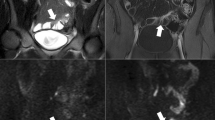Purpose: To evaluate the efficacy of breathhold MRI following enteroclysis with addition of oral magnetic particles to study the extension, detection of stenoses and extraluminal manifestations in Crohn's disease.
Material and Methods: 18 patients with Crohn's disease and potential of surgical intervention were studied with enteroclysis with addition of oral magnetic particles. T1-/T2-weighted breathhold MRI w/o spectral fat suppression w/o i. v. Gd-DTPA was applied.
Results: Typical findings were marked bowel wall thickening with strong contrast enhancement. 95.8 % of affected small bowel segments and 94.7 % of stenoses were correctly detected by MRI. All four fistulas were detected and important extraluminal findings were seen in 6/18 patients. Additionally, one ileoileal and two ileosigmoidal adhesions, two extraluminal abscesses and affection of the right ureter were delineated.
Conclusion: MRI in Crohn's disease offers the potential to avoid radiation exposure in this relatively young patient group. Important additional findings relevant to indication of surgery are seen in approximately one third of cases. The replacement of transduodenal intubation by oral contrast application remains to be further studied.
Zusammenfassung
Das Ziel dieser Arbeit war der Vergleich der diagnostischen Effizienz des konventionellen Dünndarmenteroklysmas mit anschließender MRT mit negativem oralem Kontrastmittel bezüglich der Ausdehnung, Stenoseerkennung und relevanter Zusatzinformationen bei Morbus Crohn. 18 Patienten mit Morbus Crohn und möglichem operativen Vorgehen wurden zunächst mit Enteroklysma unter Beimischung oraler Eisenpartikel untersucht und anschließend mittels MRT mit T1-/T2-gewichteten Atemstillstandsmessungen ± Fettsuppression und ± Gd-DTPA untersucht. Die typische Befundkonstellation im MRT bestand aus einer ausgeprägten Darmwandverdickung mit starker Kontrastmittelaufnahme. Im Vergleich mit dem Enteroklysma konnte die MRT-Untersuchung 95,8 % der befallenen Segmente und 94,7 % der Stenosen identifizieren. Alle 4 Fisteln wurden detektiert und zusätzliche relevante Befunde in 6 von 18 Patienten gesehen (eine ileoileale und 2 ileosigmoidale Adhäsionen, 2 extraluminale Abzesse und ein entzündlicher Pseudotumor mit Einbeziehung des rechten Ureters). Das Stenosegrading zeigte keine signifikanten Unterschiede (p = 0,11). Zusätzlich wurden extraluminal eine mesenteriale Lymphadenopathie (15/18) und mesenteriale Fettgewebsproliferation (12/18) mittels MRT nachgewiesen. Die MRT stellt in einem beträchtlichen Teil der Patienten wichtige extraluminale Zusatzbefunde dar, die entscheidend für eine chirurgische Indikationsstellung sind und ist daher eine wertvolle Alternative zum klassischen Enteroklysma. Ein Ersatz der transduodenalen Füllung durch orale Gabe sollte weiter angestrebt werden.
Similar content being viewed by others
Author information
Authors and Affiliations
Rights and permissions
About this article
Cite this article
Holzknecht, N., Helmberger, T., von Ritter, C. et al. Breathhold MRI of the small bowel in Crohn's disease after enteroklysis with oral magnetic particles. Radiologe 38, 29–36 (1998). https://doi.org/10.1007/s001170050320
Issue Date:
DOI: https://doi.org/10.1007/s001170050320




